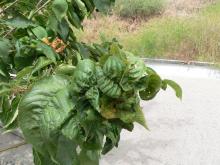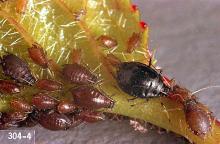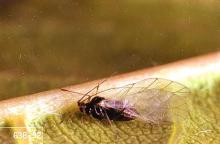Myzus cerasi
Pest description and crop damage The adult aphid is black, globular in shape and about 0.125 inch in length. The black cherry aphid is the only black aphid on cherry. These aphids curl foliage, reduce terminal growth, and deposit honeydew on cherries, which can be difficult to remove prior to commercial packing. Damage to young trees can be significant.
Biology and life history These aphids overwinter as eggs in crevices and twigs. The eggs hatch near budbreak, and the nymphs feed on unopened buds and the undersides of leaves. Nymphs inject a toxin into leaves, causing them to curl and protect the aphids as they feed. After two to three generations, winged forms emerge that migrate to summer hosts, which include weeds, ornamental plants, vegetables, and plants of the mustard family. After several more generations, the winged forms migrate back to the fruit trees in the autumn to mate and lay the overwintering eggs.
Pest monitoring Begin observing shoots before budbreak, as management is best undertaken early while the aphids are small and prior to leaf curl.
Management-biological control
Aphids have many natural enemies, which include lady beetles, syrphid fly larvae, and green lacewings. Avoid broad-spectrum insecticide applications that would disrupt these biological controls.
Management-cultural control
Home orchardists: Wash aphids from plants with a strong stream of water or by hand-wiping. Aphids are difficult to control once leaves begin to curl as insects are protected within the curled leaf from direct contact by water and chemicals. Aphid populations tend to be higher in plants fertilized too liberally with nitrogen. Avoid excessive watering which, together with nitrogen applications, produces flushes of succulent growth.
Management-chemical control: HOME USE
Warning: These pesticides are hazardous to bees. Look for bee precautionary statements on product labels and do not use these products during bloom or if bees are foraging in the orchard.
- carbaryl-Highly toxic to bees.
- gamma-cyhalothrin-Highly toxic to bees.
- lambda-cyhalothrin-Highly toxic to bees.
- malathion-Highly toxic to bees.
- zeta-cypermethrin-Highly toxic to bees.
Management-chemical control: COMMERCIAL USE
Warning: These materials are hazardous to bees. Do not use during bloom or if bees are foraging in the orchard.
Dormant-season and delayed-dormant sprays
- diazinon (Diazinon AG500) at 4 pints/A + horticultural mineral oil (rates vary; see product label) or (Diazinon 50W) at 1 lb/100 gal water. Do not exceed 4 lb/A per year (2 lb ai/A per year). Do not exceed 6 gal of oil when applying Diazinon 50WP. REI 4 days. Do not exceed one dormant application of diazinon per season.
- dimethoate (Dimethoate 400 EC) at 1 quart/A. REI 10 days (REI is 14 days in areas where average annual rainfall is less than 25 inches). Do not exceed one pre-harvest application per season. Can cause leaf burning and fruit marking. Do not use on cherries to be exported to Japan.
Spring and summer sprays
- acetamiprid (Assail 70WP) at 2.3 oz/A. REI 12 hr. PHI 7 days.
- diazinon (Diazinon 50W) at 1 lb/100 gal water. Do not exceed 4 lb/A per year (2 lb ai/A per year). REI 4 days. PHI 21 days. Do not exceed one in-season foliar application per year.
- esfenvalerate (Asana XL) at 4.8 to 14.5 fl oz/A. REI 12 hr. PHI 14 days. Asana may aggravate spider mite problems. Extremely toxic to fish and aquatic invertebrates; avoid spray drift and runoff to surface waters.
- imidacloprid (Prey 1.6F) at 4 to 8 fl oz/A. REI 12 hr. PHI 7 days. Do not use until pollination is complete and bees are no longer present in canopy or ground cover.
- malathion (Malathion 57EC) at 1.5 pints/A. REI 12 hr. PHI 3 days. Malathion may be used in the evening after bee activity. Do not apply within 300 ft of aquatic habitat.
- spirotetramat (Movento) at 6 to 9 fl oz. REI 24 hr. PHI 7 days. Do not apply until after petal fall. Limited to 15.3 fl oz/A per season.
- thiamethoxam (Actara) at 3 to 4 oz/A. REI 12 hr. PHI 14 days. Do not exceed a total of 11.0 oz/A (0.172 lb ai/A) of Actara or 0.172 lb ai of thiamethoxam-containing products per acre per growing season.. Actara is extremely toxic to bees exposed to direct treatment or residues.



